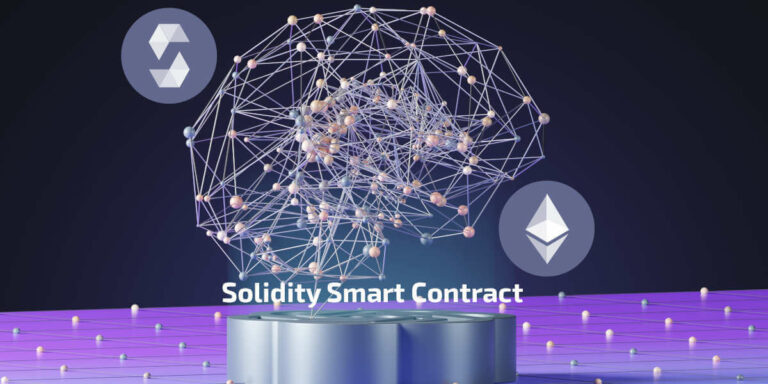
When you think of contracts, you might picture adults in suits, shaking hands, and signing papers. But in the world of technology, we have something called “smart contracts,” and they’re written in a programming language named “Solidity.”
In the rapidly evolving world of blockchain and decentralized technologies, the term “solidity smart contract” frequently stands out as a buzzword. Therefore, we will dive into this beginner’s guide about Solidity smart contracts on the Ethereum blockchain.
Whether you’re an absolute newbie, a seasoned developer eager to transition to the blockchain realm, or simply a tech enthusiast, this tutorial aims to provide you with the foundational knowledge you need. Let’s embark on this exciting journey into the world of decentralized agreements together!
What is a Solidity Smart Contract?
Imagine you and your friend want to swap toys. You both agree: if you give your friend your skateboard, he’ll give you his rollerblades. This is a simple agreement or contract. A Solidity smart contract is just like this agreement, but it’s digital and runs on the computer. If certain conditions are met (like you giving the skateboard), the computer automatically makes sure the other side (your friend giving the rollerblades) happens. It’s like a robot referee making sure everyone sticks to their promise!
To understand these online deals in detail, consider reading “How do smart contracts work“.
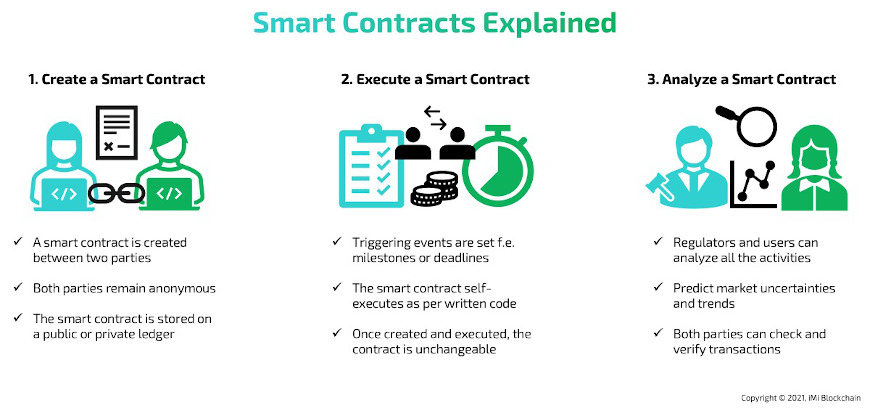
Share this Image on Your Site:
Solidity is a special kind of computer language used for smart contract programming, especially one called Ethereum. Think of smart contracts as digital agreements that automatically do what they’re supposed to when certain things happen. For example, if you and a friend made a bet about the weather and used a Solidity smart contract, the contract could automatically pay the winner when the weather result is clear.
Created in 2014, Solidity helps businesses change from using regular contracts to these digital “smart” ones. What’s cool about these contracts is they are safe, clear to everyone, can’t be changed once made, and happen right away. On top, you can even create an NFT smart contract on different platforms.
Most people create a Solidity smart contract, and it’s mainly for something called the Ethereum blockchain. Think of the blockchain as a big digital ledger where everything is recorded. Ethereum is like a popular playground where everyone can come and use or make these contracts.
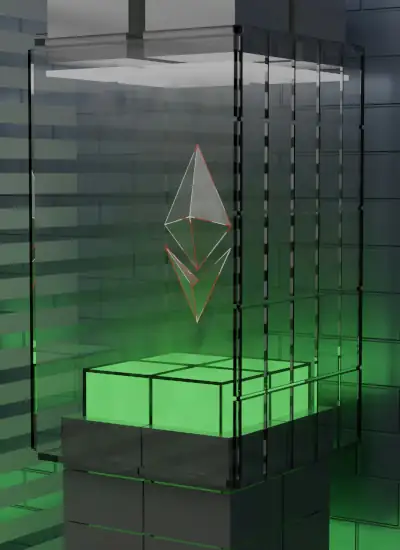
Unlock Your Business Potential with Certified Blockchain Consulting!
Dive into the future of technology with our team of certified blockchain experts. Simply pick the service you need:
Personalized Advice – tailored to your business needs.
Comprehensive Training – for you and your team.
Development Services – innovative solutions from the whitepaper to the finished blockchain.
Programming – with capabilities and tools to succeed.
TALK TO THE EXPERTS TODAYSmart Contract & Solidity Tutorial
For the computer to understand and enforce these digital contracts, they need to be written in a specific way. This is where Solidity comes in. It’s a special language made for writing these contracts. Think of it like learning Spanish or French but for computers.
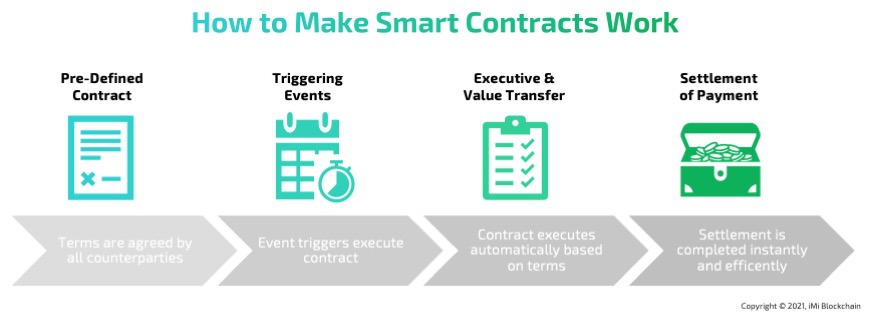
Share this Image on Your Site:
Solidity is like a special computer language used to make smart contracts. Think of a Solidity smart contract as rules or agreements on the Ethereum system.
Solidity uses certain symbols and patterns similar to other computer languages you might have heard of, like Python or JavaScript.
With Solidity, people can make rules for things like voting online, raising money for projects, or even creating a secure online wallet to hold money.
It’s important to always use the most recent version of Solidity when making these rules. This is because the newest version is the safest and has the most up-to-date features. The version numbers look like 0.y.z to show that it’s always changing and improving.
How do Solidity Smart Contracts Work?
Imagine a vending machine. You insert a coin, and you get a candy bar. That’s the machine’s “contract” with you: one coin equals one candy. A Solidity smart contract works similarly but on the computer.
- The Rules: Just like how the vending machine knows the price of the candy, the Solidity smart contract has rules (like “if you give 10 digital coins, you get a virtual sticker”).
- The Action: When someone follows the rule (puts in the right amount of coins), the contract automatically does its job (gives out the sticker).
- Safety First: Once the contract is live, it can’t be easily changed. So, people can trust it. It’s like a vending machine that can’t be easily tampered with.
Why are Solidity Smart Contracts Important?
These contracts are super useful in the digital world and here is why they are so important:
- Trust: People can be sure the contract will do what it says because it’s run by a computer, not a person who might forget or change their mind.
- Speed: Things happen fast because it’s all automatic.
- Savings: Without needing people to check and double-check, it can save time and money.
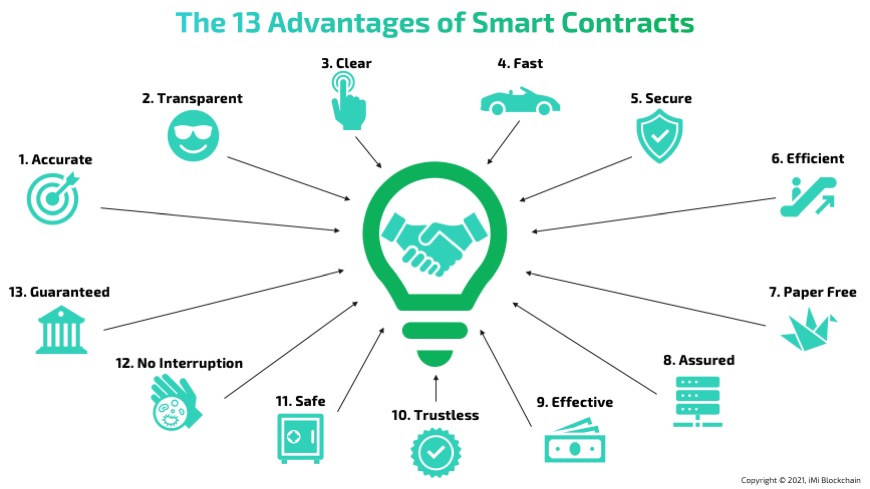
Share this Image on Your Site:
You can use a Solidity smart contract in almost all industries and sectors. Use your imagination and for sure you will find thousands of amazing applications with huge optimization oppertunities.
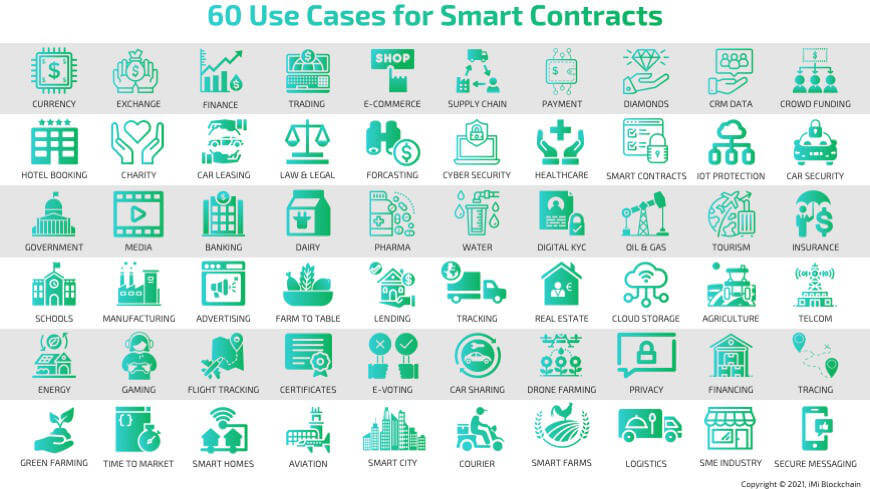
Share this Image on Your Site:
Understand a Basic Solidity Contract
If you are new to Solidity smart contract, then you should get started by learning from simple examples. You can always copy and paste code examples and play around with them. See what is in it and how it works.
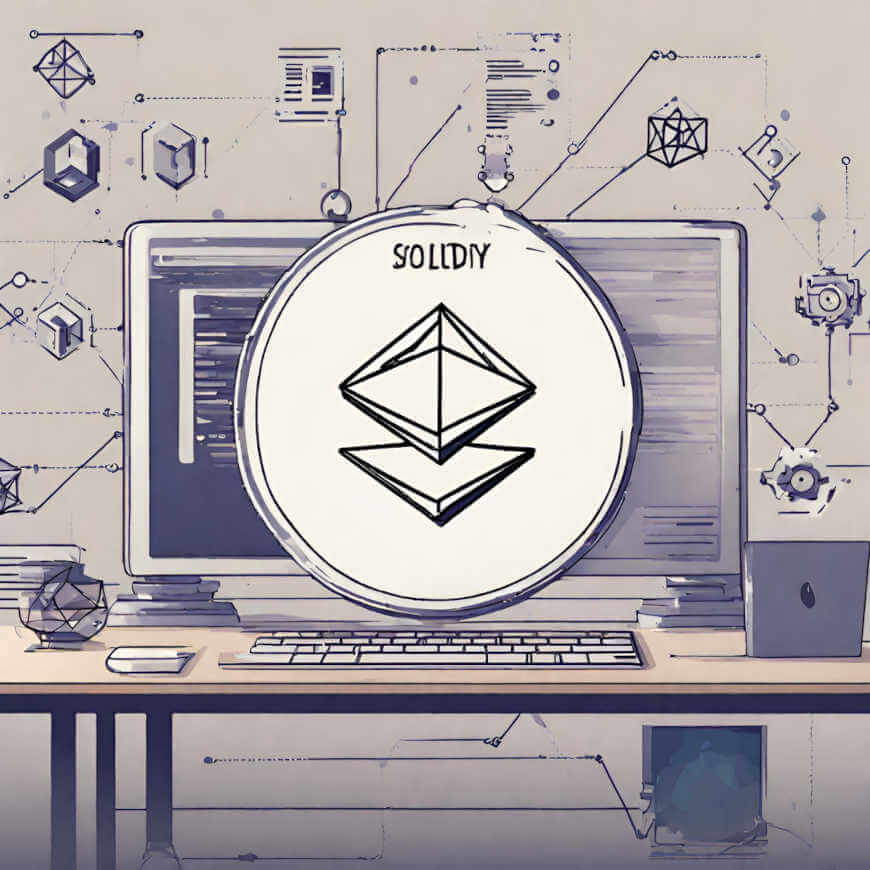
Share this Image on Your Site:
The steps for getting started with a basic solidity contract are the following:
Get to know Solidity Programming Language

Before you jump into Solidity programming you should make sure that you understand the basics. Here is what you need to know in short:
Blockchain & Ethereum Smart Contract
- What is Blockchain? Think of it as a digital ledger (like a book) where you can write entries, but once you’ve written them, you can’t change or erase them.
- What is Ethereum? It’s a particular type of blockchain that allows you to run programs, called “smart contracts.”
- What is a Smart Contract? It’s a self-executing contract with the terms of the agreement directly written into code. It can move digital money around and make decisions, based on certain conditions.
Once you have learned the basics of the Solidity programming language, you can look at a simple code example and code description. This way, you will understand the basic concepts of the language.
Get Started with a Basic Solidity Contract
Solidity is a programming language used to write smart contracts for the Ethereum platform. It looks a bit like JavaScript but has its unique characteristics. To get started, you can follow these steps:
Install the Solidity Compiler
When you write code in Solidity, you will need a Solidity compiler, which outputs byte code and other artifacts for the deployment of a Solidity contract.
Setup your Environment

Use online platforms like Remix IDE. It’s a web-based Solidity IDE (integrated development environment) and debugger. You can write, test, and deploy your Solidity smart contract right from the browser.
How to Learn Solidity Smart Contract Programming?
Just like you learn English, Math, or Science in school, people can learn Solidity. There are online courses, books, and even some schools that teach it. Who knows? Maybe you’ll be writing your own Solidity smart contract one day!
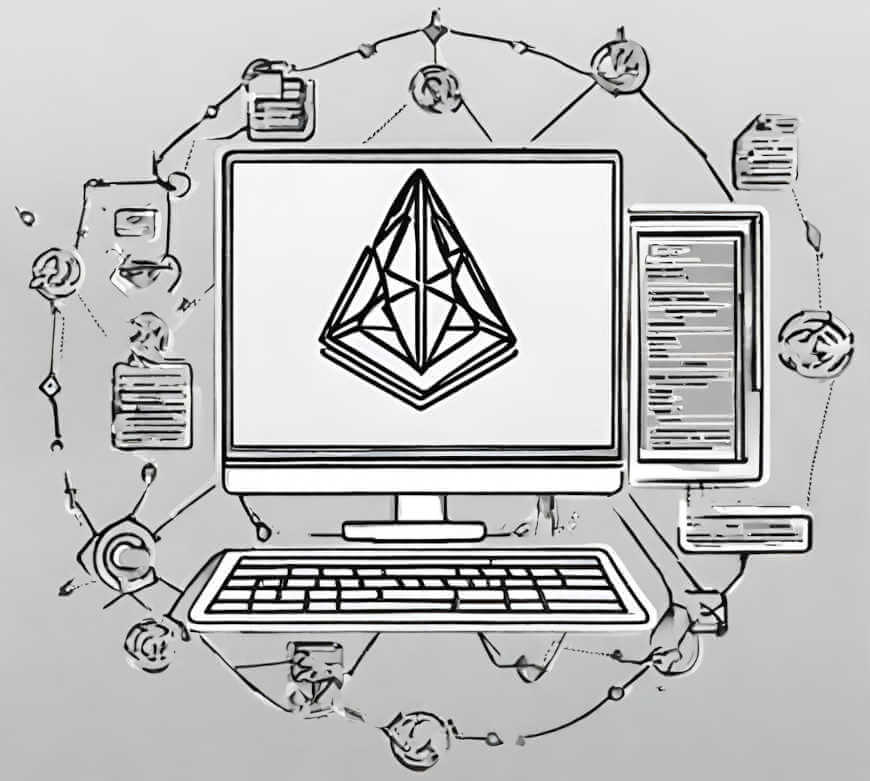
Share this Image on Your Site:
Imagine you’ve played video games where you can earn and trade items. In some of these games, people trade rare items and even sell them for real money. Now, imagine there was a super-secure online bank where these items could be stored, and every time someone traded or sold an item, there was a bulletproof record of it, so no one could cheat. That’s the idea behind a blockchain – a digital system where every transaction is securely recorded.
Solidity is the language we use to create programs (called “smart contracts”) on the Ethereum blockchain platform. These contracts are like automatic vending machines on the internet. You put something in, like a coin, and the machine does its thing based on the rules programmed into it, like giving you a soda.
Let’s break it down further:
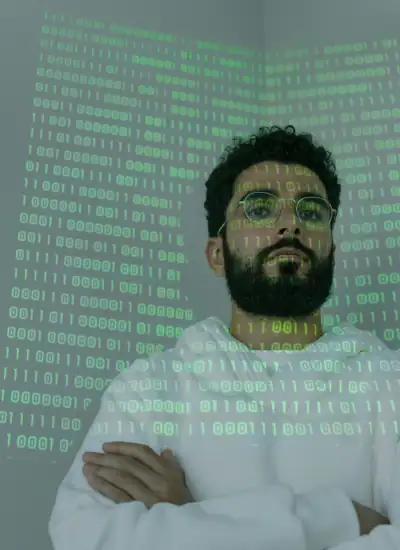
Unlock the Code: Master Blockchain Programming!
Dive into the world of decentralized technology with our comprehensive online programming courses. Learn at your own pace and get:
Access – to expert instructors.
Interactive – coding exercises.
Vibrant – community of like-minded learners.
Certified – receive your recognized diploma.
ENROLL TODAY AND TRANSFORM YOUR FUTURE!Basic Solidity Concepts
- Data types: Learn about basic data types like
uint256(unsigned integer),address(for Ethereum addresses), andstring(for text). - Functions: Functions are sets of instructions that you want your contract to perform. For example, a function could be set to transfer some Ether (Ethereum’s cryptocurrency) from one person to another.
- Visibility: Functions and state variables have attributes like
public,private,internal, andexternal. This defines who can access them. - Variables: These are like little boxes where you can store things. Maybe a number, a word, or even a longer text.
- Events: These are like alarms or notifications. When something important happens in the smart contract, it can shout out an event to let everyone know.
- Modifiers: These are ways to log and monitor specific activities happening in your contract.
- Gas: This one’s a bit tricky. In Ethereum, every action costs some amount of “gas” (not the kind you put in cars!). It’s like a small fee to get your program to run. If you don’t pay enough gas, your program might not finish.
ERC-20 Tokens: Learn how to create your own cryptocurrency using the Ethereum platform. The ERC-20 standard is a set of rules that your token must follow.
Storage vs. Memory: Understand the difference between permanent storage (more expensive) and temporary storage in your contracts.
Safety: Solidity is powerful, but with great power comes great responsibility. If there’s a mistake in your program, someone might steal all the coins or make the program unusable. That’s why it’s super important to test and be careful.
A Simple Smart Contract in Solidity
Let’s start with an easy and simple smart contract example using Solidity programming language. We’ll set a value and let other contracts see it. Don’t worry if you don’t get everything now, we’ll explain more later.
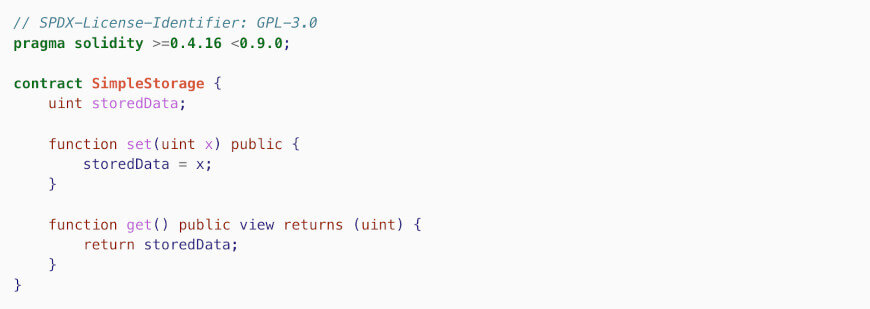
The beginning says this code follows some rules, kinda like saying a game is played by certain rules. This helps make sure everything works right.
The code is written for a specific version of a language called Solidity, kind of like saying a game works best on certain game consoles. This is to make sure the game (or code) doesn’t act weird if played on a different console (or with a different version).
In this world of coding, a “contract” is like a box. Inside this box, there are things it can do (functions) and information it keeps (data). There’s a spot in this box that can hold a number. We named this spot “storedData”.
There are two main things this box can do:
- Change the number in the “storedData” spot.
- Tell you what number is in the “storedData” spot.
Usually, in some games or apps, you might use the word “this” to talk about something inside it. Here, you don’t need to. It’s like having a toy in a toy box and just calling it “toy” instead of “this toy”.
This box is pretty simple. Anyone can put a number in it. But, anyone else can come and change that number too. It’s like a public bulletin board where you write a message, but anyone can come and write over it. However, all the old numbers are remembered, like keeping old notes even if they’re covered up. Later on, we’ll learn how to keep our bulletin board private so only certain people can write on it.
Is Solidity just for Ethereum?
While Solidity was specifically made for Ethereum, it’s not just for Ethereum. It can be used for other blockchain platforms that are similar to Ethereum, but there might be some differences or tweaks needed.
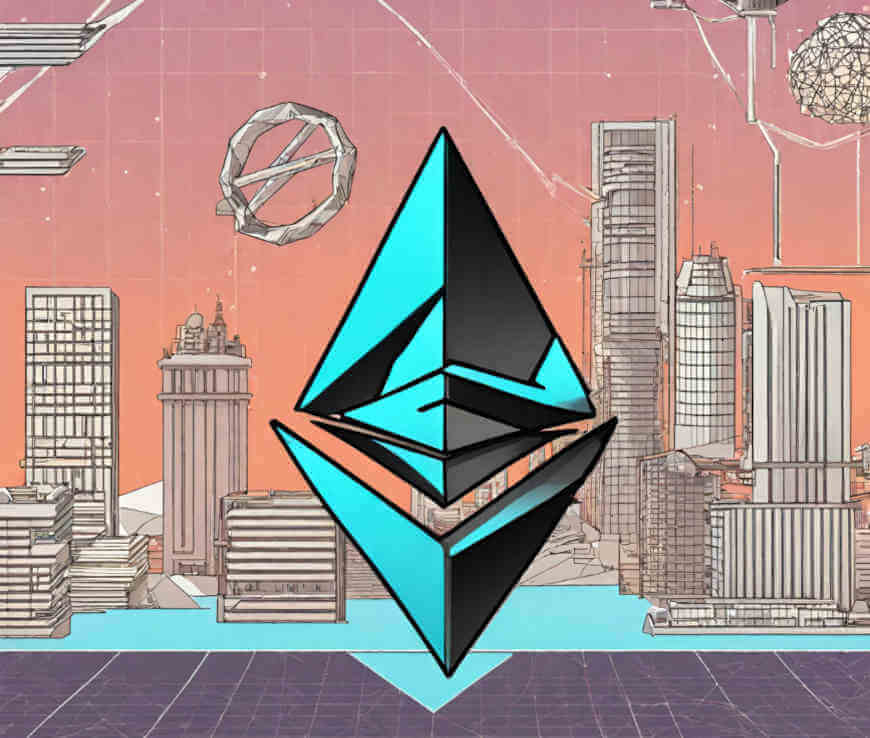
Share this Image on Your Site:
Imagine you have a gaming console, like a PlayStation. To play games on it, you usually need games specifically made for the PlayStation. Similarly, Ethereum is like a gaming console, and Solidity is the language used to create “games” or, in this case, smart contracts for it.
Now, just like how you might find some games that can also work on other consoles with slight changes, Solidity, which was primarily designed for Ethereum, can be used on other blockchain platforms too. These other platforms, such as Avalanche, Polygon and Binance Smart Chain, are kind of like “cousins” of Ethereum, as they have similarities with it.
Conclusion
So, a Solidity smart contract is like a super-smart, trustworthy robot referee who makes sure everyone keeps their promises in the digital world. As technology grows, these contracts become more important. And just think, you now know something super cool that even some adults might not understand!
Remember the next time you’re trading toys, snacks, or maybe even digital stickers, that there’s a whole world of smart contracts out there making sure everything’s fair and square! If you like to learn everything in detail, then join our iMi Blockchain Academy. In case you’re looking for someone to check or implement a digital contract for you, then contact one of our experts today.
Learn all about Blockchain!
Blockchain Training in small Classes
Webinars about Blockchain
Courses at University Level
Free Blockchain Tips!
Get monthly tips on Blockchain.
On top, you’ll get our free Blockchain beginners course. Learn how this technology will change our lives.


